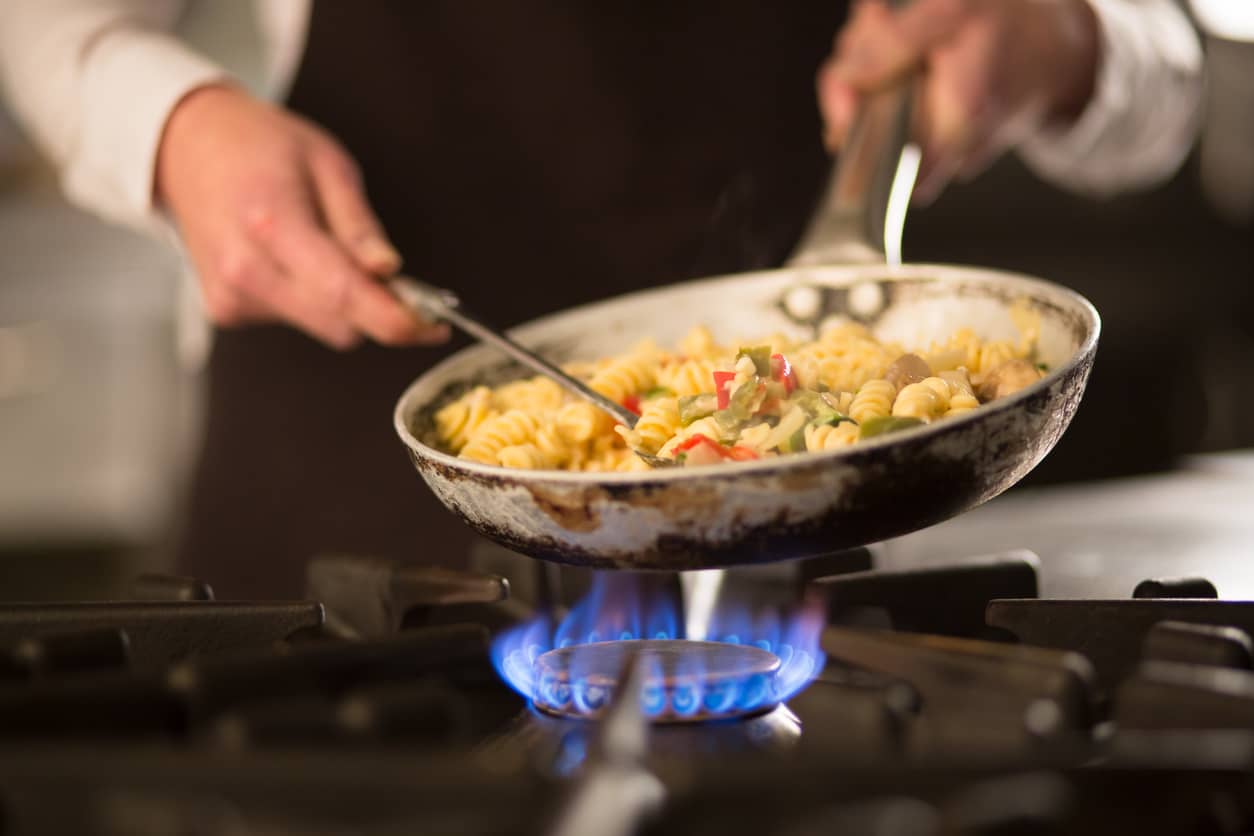Do you wish there was a way to spend less time cooking and always have plenty of nutritious meals, ready to heat and serve? Batch or bulk cooking, combined with effective meal planning and prepping, is a great way to accomplish this. Read on for 13 tips on how to utilize these techniques to your advantage and save time cooking throughout the week!
Note: This post may contain affiliate links. This means that any purchases through these links may generate a small commission for us, at no cost to you. As an Amazon Associate I earn from qualifying purchases.More info can be found in our full disclaimer here. Thank you for your support!
When it comes to making dinner, many of us love the idea of saving time. We may not have hours to spend in the evenings, cooking a nice hot meal, or we may just be too tired after a full day to continue working in the kitchen. We want to eat healthy, but in the end, we may just order takeout or delivery. How does one avoid doing this all the time? How can we enjoy a nutritious homecooked meal with less effort?
What is Meal Planning, Prepping, and Batch Cooking?
Meal planning, prepping, and batch cooking can help to solve these problems.
- Meal planning involves planning your meals in advance for a certain period of time, i.e. for the upcoming week. This removes the burden of deciding each day what you might cook.
- Meal prepping can mean preparing various aspects of your meals (or even the entire meal) in advance and then cooking it later, or it can simply describe using a more efficient process while cooking.
- Batch cooking involves cooking multiple portions at once, allowing easy access to meals and removing the need to cook each meal from scratch. (This can easily include cooking multiple recipes too, so you have several options to choose from any time you open the fridge.)
Each of these methods can be a major time-saver when cooking your own meals (and help you save money and eat healthier if you get takeout less!).
Here are some tips to get the most out of these cooking methods and save time and effort, while still allowing yourself to enjoy meals that taste delicious!
Meal Planning Tips:
1. Review the contents of your pantry and fridge when planning the week’s menu. Do you have any perishable items that need to be used sooner rather than later? Do you have a large quantity of any particular item? Do you have items in your cabinet that you may have forgotten about but that are still good? If so, keep these in mind when planning which recipes to prepare for the upcoming week; this will save money by buying less at the grocery store, and it may help to narrow down your potential choices for recipes, making your decision easier.
2. Have a sizable selection of recipes to choose from. You can obtain these from cookbooks, or print online recipes to collect in a binder. Allrecipes.com has lots of great recipes, posted by normal folks, with lots of helpful reviews providing tips and tweaks (I always check the reviews labeled as most helpful and typically add some of the tweaks when I prepare the recipes myself).
3. Mix it up. Choose different recipes each week; don’t use the same ones week after week. This way, you won’t get tired of any of them. This is why it’s a good idea to have a large recipe collection. In addition, when deciding upon one week’s recipes, choose a variety, with different flavors and proteins. This way, if you plan on doing batch cooking, you’re not eating the same thing for every meal.
4. Choose recipes that will work well as leftovers if you plan to batch cook. When refrigerated and reheated, certain foods will taste better than others and will maintain the same qualities as freshly cooked. For example, in my experience, homemade Alfredo sauce cooked from scratch does *not* tend to reheat well: the butter tends to separate after being refrigerated and then reheated. (I tried it once and only once in the microwave – perhaps reheating on the stovetop would work better. If you’ve done it successfully, let me know how by commenting below.) Cooked dumplings (as in chicken and dumplings) are also best to eat fresh off the stove, since the dough congeals when refrigerated after cooking. Most other items in my experience will reheat perfectly fine, provided you use the proper method (see tip #6 in Batch Cooking below).
Meal Prep Tips (useful whether you’re doing batch cooking or not!):
1. Do similar tasks all at one time. For example, if you’re making a large amount of vegetables, chop all of them in one go. Cook them all using the same method (roasting, sautéing, etc.). This way you’re able to move faster, and fewer pots and pans are used. I recommend roasting lots of veggies on large sheet pans; this way you can cook a large volume of vegetables, and cook something else at the same time.
2. If only one item is going in the oven, prepare that one first. When it goes in the oven, you can start on the next dish and be “cooking” the two simultaneously. If you’re really good at multi-tasking, you can extend this to stovetop dishes (personally, I tend to lose track of cooking time on one pot once I start a second one on the stove, so I’m not the best at executing this with stovetop dishes, but if you can, more power to you!).
3. You may be able to prep certain aspects of a recipe a few hours or a day prior to actually cooking it. For example, vegetables can be chopped and then sealed in an airtight container in the fridge for a few days before use (wait until use to rinse, though, since excess moisture allows it to go bad more quickly). Meat can be placed in marinade up to 6-24 hours ahead of cooking, allowing it to soak up flavor (source: USDA).
Batch Cooking Tips:
1. Plan how many portions of each recipe you need, and use that to determine how many recipes to cook. If you plan on cooking twice during the week, then you’ll need to cook enough for 3-4 days, or 6-8 meals per person. Make things easy by choosing recipes that will serve 6-8, or double a recipe if it serves 4. (Essentially 2 recipes per person per week.) Then figure out how many recipes you need by multiplying by the number of people you’re cooking for. I cook for my mom and myself, so I cook 3-4 recipes during the week plus lots of veggies. Each recipe that I cook has between 6-8 servings. Keep in mind that you’ll need to eat all leftovers within 3-4 days, so only make what you know you’ll be able to eat within that time period (source: Mayoclinic – you can also check out a handy guide from the FDA here on how long different foods last).
2. Set aside enough time to be able to cook several recipes from start to finish. Cooking multiple recipes allows you the ability to choose from a few different ready-made options when you open the fridge for dinner. If you plan on eating one of your dishes immediately, make that item last, after the others on your list.
3. Casseroles and roasting large quantities of vegetables are great when batch cooking, as they provide quite a few meals easily. Casseroles can be pretty quick to prepare, depending on the recipe, and usually tend to require a larger baking dish, allowing multiple portions. Using 1-2 large sheet pans to roast veggies is also a relatively simple way to cook a lot of food; simply toss them with olive oil, salt, pepper, and some other seasonings or spices, and put them in the oven (higher temps, around 400-450 degrees, and about 20-30 minutes usually do the job, depending on the vegetable, with harder vegetables like potatoes taking longer within that window).
4. Clean as you go. Place items in the dishwasher as soon as you’re done with them, rather than piling them up in the sink. Wash pans and other non-dishwasher-safe items immediately after use unless they require a good soaking. This will save clean-up time in between recipes as well as at the end of your cooking session.
5. Have plenty of Tupperware or other storage containers available. Box up dishes in these containers immediately upon completion. I love Duralex glass storage containers for this purpose.
6. Perhaps the *most important* tip: Learn the best method to reheat leftovers so they retain their freshly-cooked yummy-ness. Many items will be fine reheated in the microwave. However, any baked items that were crispy upon coming out of the oven (i.e. baked “fried” chicken or quesadillas), or any fried items (like French fries) would be better off reheated in the oven (or a toaster oven with an oven or special reheat setting – I use my Breville toaster oven on Reheat, and items come out perfectly crisp the second time around). Even things like pancakes made on a griddle can be reheated in the oven, as long as they don’t have syrup on them. Basically, use the oven to reheat anything that the microwave might otherwise turn soggy, and your leftovers will be just as yummy and crisp as the original!
Takeaway
Meal planning/prepping and batch cooking can be definite time savers when preparing dinner. Planning the week’s meals can alleviate stress of figuring out what to cook. Prepping large amounts of food, multiple recipes, or even just parts of a recipe like chopped vegetables, can save you time in the kitchen. Utilizing some or all of these techniques and tips can take away some of the worry and allow you to devote more time to enjoying those yummy dishes! Happy cooking (and eating)!
For related reading, check these out:
Items mentioned in this post:
(I know the Breville may look expensive, but I swear by this contraption – hands down, one of the best purchases I’ve ever made for my kitchen. Better than any toaster oven I’ve ever had – it really does allow me to reheat or cook pretty much anything flawlessly.)
Cover image photo credit: IStockPhoto.com/beaer_photo




